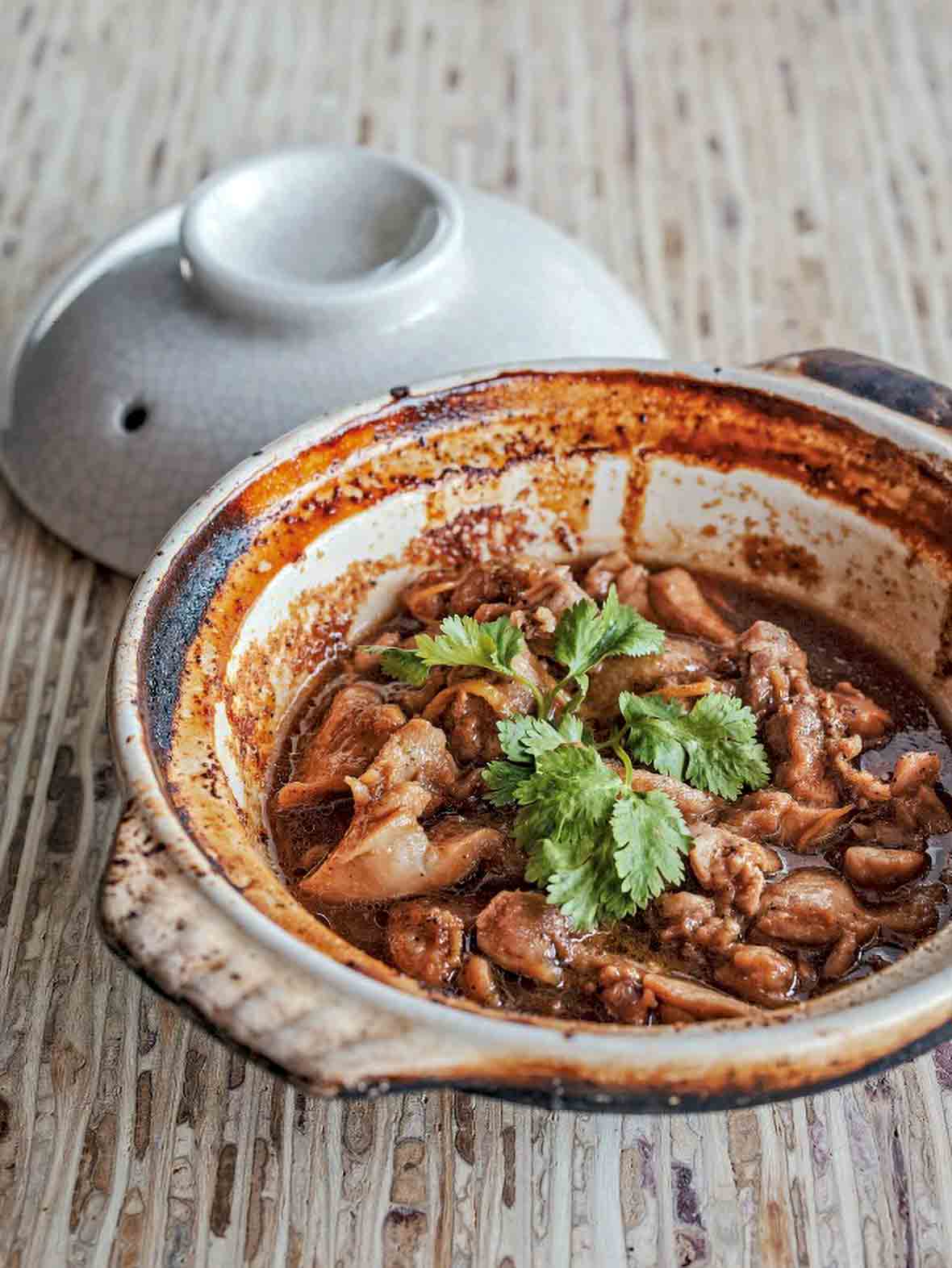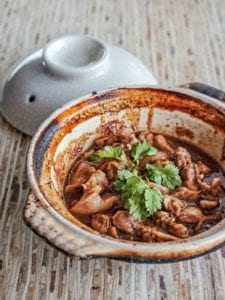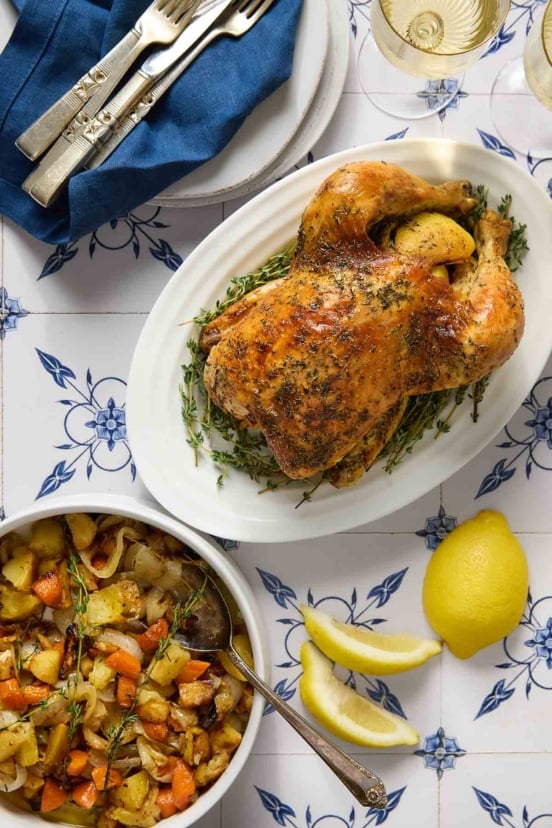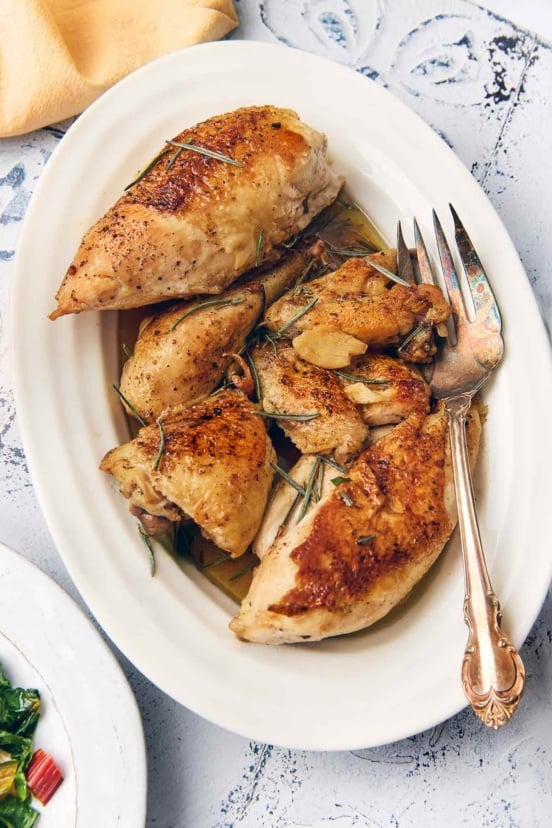

This lovely little Asian number comes from the iconic Slanted Door restaurant in San Francisco, where it’s been on the menu since opening day. Vietnamese caramel chicken is traditionally made with bone-in chicken, but this recipe relies on boneless, skinless dark meat to save time and fuss. The recipe couldn’t be simpler—especially when you toss together a batch of the savory caramel sauce ahead of time and stash it in the fridge for crazy or lazy weeknights.–Renee Schettler Rossi
Something Smells Fishy Note
Full disclaimer. Fish sauce smells something terrible straight out of the bottle—and even worse when it’s subjected to heat. So don’t say we didn’t warn you to fling open the windows and crank the exhaust before you even think about making this stinky yet savory caramel sauce. That said, the end definitely justifies the means in this situation. Especially when you make a big batch of the Vietnamese caramel sauce—the way we see it, while you’re stinking up the house, you may as well REALLY stink it up so the results of your efforts linger. Simply stash any extra sauce in the fridge so you can satisfy weeknight cravings for this aramel chicken in just 25 minutes. You’re welcome.

Vietnamese Caramel Chicken
Equipment
- Claypot (optional)
Ingredients
For the Vietnamese caramel sauce
- 1 pound Asian palm sugar*, coarsely chopped
- 1 1/4 cups fish sauce, (we prefer Three Crabs brand but any fish sauce in a glass, as opposed to plastic, bottle is preferable)
For the Vietnamese caramel chicken
- 12 ounces boneless, skinless chicken thighs, (about 4), trimmed
- 2 tablespoons mild olive oil or vegetable oil
- 1-inch piece fresh ginger, peeled and julienned
- 2 medium shallots, thinly sliced lengthwise into rings
- 1 to 2 Thai or serrano chile peppers, halved lengthwise and seeded, if desired
- Cilantro leaves and stems, chopped, for garnish
- Freshly ground black pepper
- Steamed jasmine rice, for serving
Instructions
Make the Vietnamese caramel sauce
- Dump the palm sugar in a small saucepan over medium-low heat and wait until the sugar sorta melts, which can take anywhere from 5 to 25 minutes. (If substituting light brown sugar for the palm sugar, you’ll need to add a tablespoon or two cold water to the sugar before you place it over the heat and stir almost constantly as it melts.) Palm sugar is still a touch grainy even when it melts and that’s okay. It may smoke ever so slightly, and that’s okay. If the sugar appears to seize or scorch, though, lower the heat and go ahead and stir it.
- Meanwhile, measure your fish sauce and have it at the ready.
- When the sugar melts, turn off the heat under the sugar and slowly and carefully stir in the fish sauce, taking care as it may bubble and spatter. If the sugar seizes into clumps, simply return the pan to low heat and stir until everything melts once again. Let cool. The caramel sauce will thicken as it cools. Store in an airtight container for up to 1 month.
Make the Vietnamese caramel chicken
- Cut the chicken thighs into bite-size pieces.
- In a 10-inch claypot or sauté pan over medium heat, heat the oil. Add the ginger and shallots and sauté until softened, about 2 minutes. Increase the heat to medium-high and add the chiles, chicken, and 1/4 cup caramel sauce. Bring to a boil, then turn the heat down and simmer, uncovered, stirring or turning the chicken occasionally, until the chicken is cooked through and the sauce is bubbling, a shade darker, and thicker and stickier, 10 to 20 minutes. Garnish with cilantro and gobs of black pepper. Serve immediately with steamed rice.
Notes
What Is Palm Sugar?
The kind of palm sugar that you want—and need—for this claypot chicken recipe typically comes in a hard disk of palm sugar shrink-wrapped in plastic or tightly packed in a clear plastic jar. The palm sugar looks sorta like sand after the tide has gone out and left it drenched and packed down. It is sometimes labeled coconut sugar. You can also use Indian jaggery. Do not substitute granulated organic coconut palm sugar found at health food stores or your attempt at melting it will be a spectacularly epic fail resulting in the possible destruction of your saucepan. Trust us. Asian palm sugar has a higher moisture content which enables it to behave more collegially as it melts than the health food stuff.Nutrition
Nutrition information is automatically calculated, so should only be used as an approximation.
Recipe Testers’ Reviews
So, so good. This dish blew us away. The sticky sauce hits all the right notes—aromatic, salty, spicy, sweet. Thigh meat is genius here because it stays juicy and won’t get tough like white meat can. I love that there’s no frenetic, stressful stir-frying. Instead dinner coasts to done with a lazy, easy simmer. There’s plenty of time to steam some broccoli, dig out the chopsticks, and pour a drink. We’ll make this again and again. It is INSANELY GOOD. I’d scale the caramel sauce to make 1 cup (6.5 ounces sugar and 1/2 cup fish sauce). This took less time and was easily measured. BTW, hot fish sauce STINKS TERRIBLY, how can this be food! A pound of chicken served only 2 with rice and steamed broccoli. No seconds were to be had—and we wanted them badly.
The chicken cooked up just as the recipe states and was enjoyed by all. After the caramel sauce is made, the recipe is a breeze to come together and the final result is delicious.
Be forewarned, if you have never cooked with fish sauce, it stinks and your house will smell. Just turn on all exhaust fans. The final dish is worth the temporary smell, in my opinion. Another option if you don’t want the smell is to cook the caramel sauce on an outdoor grill burner.
Because fish sauce is so incredibly salty and I was only interested in making enough caramel for 1 to 2 recipes, I only made half the sauce recipe (8 oz palm sugar chopped carefully as it is very hard and 1/4 cup fish sauce) which yielded 3/4 cup caramel sauce. I actually was skeptical that the sugar would melt with no added water, but it did. It took about 8 minutes.
When melting down the sugar in your saucepan, have your fish sauce measured and ready to go. My bottle of fish sauce did not pour out, it has a small hole at the top and you have to shake the liquid out of. I didn’t have my fish sauce premeasured and as a result while measuring fish sauce my sugar got too cool within the minute or so I was measuring. I had to reheat the sugar again.
I used a Dutch oven since I do not have a clay pot. On to the ingredients. My Thai chiles were HOT. Proceed with caution if you are not into spicy food. Next time, I may only use half the full recipe amount to suit those who don’t care for spicy hot. Even with my doubled recipe, it only served 3 people when served with jasmine rice. I have caramel sauce left and I will use it for another batch.
The author is right—once you have the caramel sauce ready to go, you’ll have this delicious Vietnamese dish on the table in no time at all. The sauce is sweet and salty and the chiles and ginger add nice heat and flavor.
Although most of the steps are a breeze, the caramel sauce needs cautionary side notes to make it a success. The recipe makes approximately 2 cups of sauce, leaving you with 1 3/4 cups of it for later use within a month. Halve or quarter the recipe if you feel that’s too much to have on hand in the fridge. If you can’t find or don’t want to bother purchasing pure palm sugar and you use light brown sugar instead (which I did), be sure to add water or some of the fish sauce at the beginning so that the sugar can dissolve in the liquid first before it starts to caramelize. Without liquid, the brown sugar would just scorch in the pan. I think the general rule of thumb is 1/4 cup liquid per 1 cup sugar. Bite-size chicken thighs should not take 20 minutes to cook through. I thought 10 minutes was adequate–the chicken was fully cooked and the sauce had thickened nicely.
Depending on your guests’ preferences or restrictions, you can replace the chicken with shrimp, fried tofu, or a vegetable such as broccoli florets, all of which cook much faster than chicken. My taster and I thought that this recipe yielded JUST enough four 4 people.
This recipe is a stinker. But wait, not stinker as in bad, but stinker as in it will make your entire kitchen smell like fish sauce! The results of the smelly cooking process is actually really delightful chicken with deep flavor and a warm and spicy heat from the ginger and chiles. Making the caramel sauce is easy but it does stink up the kitchen because you’re working with fish sauce. If you don’t like the smell of fish sauce, open the windows and turn on the vent to high. Just remember, it will be worth it when you taste this dish!
There’s really no need to make the large amount of caramel sauce as indicated in the recipe unless you plan on making this dish many more times within a month’s time. I think you could easily halve the caramel recipe and have just enough for a few nights of caramelized chicken.
The recipe has you take the melted sugar off the heat before adding the fish sauce. This didn’t work for me because the fish sauce (at room temperature) ended up cooling the mixture down so fast that the sugar began to harden into clumps. I ended up putting the pan back on the heat to try to re-melt the clumps and it mostly worked. Next time, I’ll either keep the sugar on the heat (and be extra, extra slow and careful with adding the fish sauce) or perhaps, I’ll heat up the fish sauce so it doesn’t cool down the melted sugar so fast. Next time I’ll make the caramel sauce ahead of time so I don’t have to wait for it to cool plus this allows for the fish sauce smell to dissipate before the family sits down for dinner.
For the Thai chiles, I used two but took out the seeds and this was the perfect amount of heat for me-a noticeable heat but not overwhelming. For those that like things to be spicier, I would suggest leaving in the seeds and for those that don’t like a lot of spice, I think you can leave out the chiles and still get some warmth from the ginger. I used a 4-quart saucepan since I didn’t have a claypot and it was fine. I ended up serving the chicken in a pretty bowl instead. Granted, that’s one more dish to wash but there’s no need to run out and get a claypot.It served 2 as a full meal with a small side salad but could serve 4 if there was a heartier salad or another side dish.
If you’re into the salty sweet thing (and who isn’t?), this recipe is for you. Add a tinge of heat, as in this recipe, and you’ll have very happy tastebuds. As a bonus, it’s incredibly easy to make.
First, you’ve got the caramel sauce. I’ll be upfront with you and tell you that this recipe makes a ton of sauce. Like a half quart or so when you only need 1/4 cup. Unless you’re planning on opening a Vietnamese pop-up restaurant, halve the recipe and just scale down your saucepan, but keep in mind that having some of this sauce lounging in your refrigerator is not a bad thing because there are a ton of uses for it. For one, you can make a recipe just like this one, but with any meat or seafood you choose. Or tofu. (Seriously. Try it with fried tofu.)
The author is hoping you’ll get a Vietnamese or Thai palm sugar to use here, but there are palm sugars produced all over the world and any of them will work. I used a block of jaggery from my Indian grocer. Or, if you want to do the supermarket-friendly version, use light brown sugar. It will be fine. My sugar took 25 to 30 minutes to melt. Keep stirring as it melts. Don’t worry too much about the splattering as it was minimal.
As you can see by reading the ingredient list, this recipe only calls for 12 ounces of chicken, which, cut into pieces, is not a whole lot. I used a fairly small clay pot for this – probably 2.5-3 qt capacity, and it fit just fine. The dish could also be made in a 3-to 4-quart saucepan, a small sauté pan, a cast-iron skillet, or a small Dutch oven. It’s very forgiving. The chiles resulted in a nice, gentle burn that permeated the dish. If you want less heat, cut the chiles crosswise or don’t cut them at all. Want a lot of heat? Mince the chiles.This dish has a really nice balance between sweet, salty, and hot, that just makes it one of those craveable, more-ish dishes that will have you going back for seconds and then licking the pot. This is a dish everyone will want more of.
Fast, easy, and delicious. The caramel sauce recipe makes a HUGE batch. Part of the sauce seemed to seize like chocolate after adding the fish sauce but with slowly reheating over a low burner it all melted. When cool, the caramel sauce does thicken quite a bit. It was mildly spicy and very tasty. The black pepper really makes the dish. We found that as a first course this would serve 4 but as a dinner entree it makes enough for 2. The next time I make this I will add more ginger and shallots and maybe another chili as we found it a bit on the mild side.
This was certainly a tasty, easy supper but it could have been a little more interesting. I think this dish seriously needs an addition of vegetables for a couple of reasons. 12 ounces of chicken is definitely not enough for 4 full servings and the addition of vegetables—or tofu—would bulk it up a bit. Chicken in sauce, while delicious, isn’t very interesting. For a more grown-up and nutritious dinner, I’d add a sturdy vegetable, like Chinese broccoli, about halfway through the cooking process.
I used light brown sugar and experienced a slight problem with scorching. I wish I’d read other testers’ forum comments about adding a bit of water to reduce the chance of scorching. However, I stirred the brown sugar constantly as it broke down, and the scorching wasn’t too bad.
















Made this for dinner tonight and absolutely love. Very easy to make. I could not find the Asian palm sugar but substituted dark brown sugar and it turned out awesome. Will definitely make it again.
We’re delighted that you enjoyed it, Kent. Thanks so much for taking the time to comment.
Thoroughly enjoyed this Vietnamese Chicken with Caramel Sauce!! It is flavorful, tangy and perfect for a mid-week (or weekend) dinner. I served it over long cooking brown jasmine rice and let me say — there were no complaints. To give the dish a bit of crunch, I added chopped peanuts with the cilantro. Delicious!!
If I were to make again, I’d prepare the caramel sauce the day before to give it time to cool and thicken more. I’m planning on using this same recipe (and leftover sauce) with cut up bites of pork tenderloin. Cannot wait!!
Anne, that looks drool-worthy! Thanks so much for sharing. I can’t wait to hear how the sauce is with the pork.
Is it possible to enjoy this recipe using pork tenderloin? Why, big time, YES! I’m not sure if the caramel sauce improved over time or if the pork is a natural contender for this recipe. I only replaced the chicken with pork tenderloin, used leftover sauce and served with basmati rice and steamed broccoli. Sprinkled chopped cashews on top for that added crunch! Oh, yum!
It looks fantastic, Anne. And I’m so pleased it worked with the pork tenderloin. I’ll have to give that a try. Thanks so much for sharing.